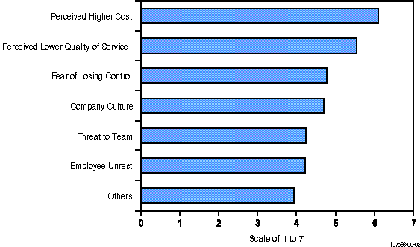|
Previous
Part - V
Other important drivers include the need to supplement IT staff and to reduce capital costs (see Figure). It is interesting to note that cost reduction is not the primary expected benefit of BPO in financial services, but that intense competition in the industry is forcing companies to optimize their back-office processing capabilities, including capabilities for noncore processes. Also, banks and insurance companies are increasingly turning to BPO as a means to adopt new technology solutions and to replace obsolete legacy applications. Their expectation is that outsourcing providers will help them through the technology transition during the first year, but also perform the necessary upgrades three or four years down the road.
Meeting these expectations defined by these drivers constitutes an important challenge for BPO providers targeting the finance sector.
Top Obstacles to Further BPO in Financial Services

Note: Drivers are rated on a scale of 1 to 7, 1=not at all important and 7=extremely important.
Source: Gartner Dataquest (June 2002).
Although financial institutions expect to achieve better service levels and reduce capital costs through the use of outsourcing, their experience with outsourcing is not entirely satisfactory. Research conducted by Gartner 2001 indicates that FSPs find outsourcing services too costly and that quality of services is not as good as expected (see Figure). These two points constitute the primary obstacles to further outsourcing within financial institutions.
Fear of losing control, as well as cultural opposition to outsourcing, constitute two other important obstacles, particularly in the insurance industry, which has traditionally been more "conservative" with regard to outsourcing than the banking industry.
Next
*Contributed by -
Deepa Dubey,
PGDIM IXth Batch,
NITIE Mumbai.
|